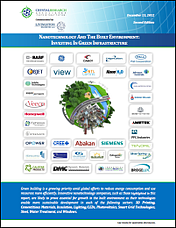NEW INDUSTRY REPORT: Guide for Investing in Green Infrastructure
**This 80-page report examines a future for U.S. infrastructure as it relates to advancements in green building being driven by nanoscience investment. Click here to read.
**According to the U.S. Green Building Council (USGBC), the market for green building could range from $120 billion to $145 billion by 2015. Innovative nanotech companies, such as those highlighted in this report, are likely to prove essential to growth in the built environment going forward.
**The greatest environmental impact of nanotechnology on infrastructure in the near term will likely occur in the areas of energy savings and resource conservation.
About the Research

Nanotechnology and the Built Environment: Investing in Green Infrastructure
As extraordinary advances take place in the field of nanoscience today, researchers are able to individually manipulate minute pieces of material smaller than atoms, yielding the ability to study the world at an ever smaller and smaller scale. The outcomes of this research have been revolutionary. But these micro-sized innovations not only enable smaller and smaller products, they also can be used to create products that perform better than before. By engineering materials at the nanoparticle level, scientists have been able to create new products that offer vast improvements in efficiency, strength, weight, heat transfer, and so on.
Specifically for the built environment, nanoscience has set the stage for a host of innovations. The most commonly employed materials in modern construction to date have been concrete, steel, glass, and timber. As an enabling technology, nanotechnology allows for the development of these materials with enhanced and/or completely new properties, such as stronger, lighter-weight steel, waterproof concrete, or electrochromic glass that changes tint in response to outside temperature and light. One of the more recent developments has been 3D printing, an advanced form of manufacturing that rarely produces any waste material.
Though not every nanotechnology-enabled product can be considered a sustainable product, nanoparticle research has greatly contributed to the introduction of building materials that offer environmental improvements, such as the conservation of raw materials, energy, and water, combined with a reduction of greenhouse gas emissions and elimination of hazardous waste. Occasionally, these benefits are achieved in the use of the product itself, such as using better insulation in the building envelope, which in turn reduces the energy required to heat or cool the building. As another example, nanostructured paints can be applied in thinner coats, which has the potential to reduce emissions of volatile organic compounds (VOCs) by as much as 65% (Source: the Institute of Technology Assessment of the Austrian Academy of Sciences, March 2012). Alternatively, benefits may occur during production of nanomaterials, such as by reducing the amount of CO2 that is emitted during manufacturing as a result of replacing environmentally damaging ingredients and chemicals with new substances.
This 80-page report details nine major market sectors related to green infrastructure, providing readers with useful information regarding market sizes, trends, opportunities, key developments, and M&A activity, as well as profiles 64 nanotech companies actively involved in these sectors.
About Our Nanotechnology Coverage
This report, Nanotechnology and the Built Environment: Investing in Green Infrastructure (December 2012), is the second edition of Crystal Research Associates’ and Livingston Securities’ Nanotechnology and the Built Environment series. The first report, Nanotechnology and the Built Environment: The Transition to Green Infrastructure, was published on November 17, 2011, and is available here.
